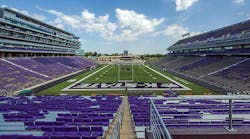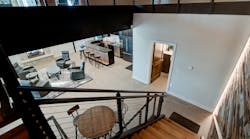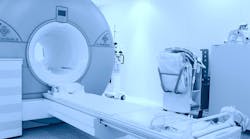With the clock ticking, a construction team had eight months to complete the largest athletic project in the history of Kansas State University — the West Side Expansion of the Bill Snyder Family Stadium. Through prefabrication, preplanning, and intense field coordination, the team wrapped up the project before opening day in the fall of 2013, when the K-State Wildcats took on the Bison of North Dakota State.
“We do a lot of fast-track work, but this project was exceptionally quick,” says Matt Torgeson, president of Torgeson Electric, Topeka, Kan., which had a $7-million electrical contract on the project. “The speed and complexity of the project made it different from other jobs we’ve worked on.”
The team wrapped up Phase 2 of the expansion project on Aug. 21, 2013, a full week ahead of schedule. During the eight-month project, the team constructed a 250,000-sq-ft, $75-million facility to replace the original facility, which dated back to 1968. The terrace level of the stadium features a Tailgate Terrace, a dining hall for student athletes, and a new fan store. The second, third, and fourth levels now feature club, loge, and outdoor suite seating; the fifth level is reserved for the media relations office.
The team also added new concessions, restrooms, ticket offices, improved media and broadcast facilities, field lighting, and other amenities. With these additions and improvements, the stadium now meets the Bowl Championship Series Games and the high-definition TV broadcast requirements.
Illuminating the stadium
The West Stadium Center, which is a key part of the Bill Snyder Family Stadium Master Expansion Plan, now serves as the northwest gateway to the campus. To finish the fast-track project, Mortensen Construction, Minneapolis, and joint venture partner, GE Johnson Construction, Colorado Springs, Colo., worked with a large team, including: AECOM/Heery, Atlanta; Henderson Engineers, Lenexa, Kan.; Olsson Associates, Overland Park, Kan.; Bigelow Consulting, Kansas City, Mo.; Torgeson Electric; and others.
As the electrical contractor on the job, Torgeson Electric’s scope of work included the installation of the electrical system, lights, safety system, fire alarm, and paging system, re-routing of primary and existing utilities for the new footprint of the building, and conduit rough-in for the AV system.
To improve the game-day experience for both the athletes and the fans, Torgeson also installed new sports lighting equipment on both sides of the stadium, which was equipped with emergency egress mounted on two structural steel catwalks. The contractor also handled installation of the parking lot lighting system.
To help save energy, electricians placed occupancy sensors in strategic locations throughout the facility and chose LED lighting for the exterior of the building. For the interior of the building, they used a combination of compact fluorescent lamps, fiber-optic strand lighting systems, and LED-based luminaires.
The construction team also transformed the existing small press box tower. They first built extensions on each side of the tower, then demolished the interior of the old tower and filled it on both sides. The electricians then rewired this area after demolition, and reconstruction of the structural features of the area were complete.
Increasing efficiency through BIM
To complete the project ahead of schedule, Torgeson Electric and the other project partners relied on building information modeling (BIM) techniques. By building an electrical system electronically before installing it out in the field, Torgeson was able to circumvent installation challenges and improve field worker productivity.
“Clash detection saves on rework, and the field coordination between all the trades is invaluable,” says Torgeson. “Since we were working on a fast-track project, there was no time for rework to happen. Everything had to be installed right the first time.”
Torgeson equipped its foremen with tablets loaded with the 3D drawings. That way, they could refer to the BIM images when installing the electrical system, particularly in those areas with varying elevations and extremely low ceilings. Within the footprint of the project, the electricians had very limited mechanical space and chases, which made it challenging to route wire from one end of the building to the other.
“It was like putting together a jigsaw puzzle,” explains Torgeson. “The project had a lot of precast concrete and structural steel, and the elevation could change six different times from one end of the building to the other. It would have been a disaster if this was not built electronically before it was installed out in the field.”
Through the use of BIM, the electrical contractor was able to obtain precise measurements, which allowed the company to prefabricate the feeder conduit before installing it out in the field. In turn, Torgeson was able to save many labor hours on the project.
Another challenge the electricians faced on the job was the lack of storage and staging areas for the project. To solve this problem, wholesalers stored the material and created some on-site mobile trailers, which were pulled on the job site in the morning and then moved to an off-site location in the evenings.
By expanding the football stadium, K-State pulled in record attendance for its 2013-14 football season. About 50,000 fans can now cheer on the Wildcats in the newly improved Bill Snyder Family Stadium, which provides an improved game-day experience for athletes and fans alike.
Fischbach is a freelance writer based in Overland Park, Kan. She can be reached at [email protected].
For additional photos and more project details, see the exclusive photo gallery.
By the Numbers
The K-State football stadium expansion took eight months to complete. At the peak of the project, about 50 electricians were on site, working an average of 50 hr to 70 hr a week during the last three months of the project. Other impressive stats on the project include:
• 218,000 sq ft of new construction
• 390 peak workers on-site every day during construction
• 750,000+ craft worker hours worked
• 479 days to build Kansas State’s Northwest Gateway
• 44 new private suites
• 37 new loge boxes
• 713 new club seats
• 56 bid packages/trade partners





